Table of Contents
How To Connect Pendive To Samsung TV?
How To Connect Pendive To Samsung TV? Newer Samsung TVs, including QLEDs and SUHDs, have USB ports that can play media files saved on a USB device. But not all formats are compatible.
First, check your TV’s specifications to determine what file formats it supports. This information can be found in the TV’s user manual or online documentation.
Activate the Pendrive:
If your Samsung TV has a USB port, you can use it to connect a flash drive or external hard disk drive. This can be helpful if you want to play video or photos on your TV without using a cable. You can also use this connection to install firmware updates. The process is fairly simple, but there are a few things you should keep in mind before connecting the USB.
First, make sure the USB device is compatible with your Samsung TV. Most newer TVs have USB ports, but some older models may not have them. If you have an older model, you can add a USB port by purchasing a USB hub or adapter. You can also purchase a USB extension cable to increase the number of available ports on your TV.
When you plug in a USB device, it should automatically display on your Samsung TV’s photo screen. However, if your TV doesn’t recognize the device, you can try an electrical reset. This process will usually fix the problem.
The most common reason for Samsung TV not recognizing a USB device is that the file system used on the drive is incorrect. Most popular TV brands (Samsung, LG, Sony, and Hisense) support FAT, exFAT, and NTFS file systems. You can use a free software tool, like AOMEI Partition Assistant Standard, to format your USB devices for Samsung TV to the desired file system.
Check the Format of the Pendrive:
When connecting a USB pendrive to Samsung TV, it is important to ensure that the USB drive is formatted properly. Different TV models support different file system formats, and the TV may not be able to read the content on the drive if it is not formatted correctly. Check the TV’s user manual or online documentation for information on which file formats are supported by your model.
Using the right USB cable is also important. Some TVs have USB ports that only work with specific types of cables. Be sure to use the USB cable that is compatible with your Samsung TV, and make sure that it is plugged in securely. Do not remove the USB cable or turn off the TV while your media is playing from the USB device. If you do, your data may be lost or the USB port could become damaged.
If your Samsung smart TV has a USB port, it can be used to play photos, music, and video files from the device. To play these files, select the USB option from the TV’s Source menu. You can use the Up/Down, Left/Right, and Enter buttons to navigate the menu. You can adjust the picture and sound settings with the OPTIONS button during playback. If you want to display a slideshow of your USB photos, press the red button in the thumbnail view.
Connect the Pendrive to the TV:
If you have a Samsung TV with USB ports, you can connect a pen drive to it and watch your favorite media content. It is important to note that some Samsung TVs may require a firmware update before they can support certain types of USB devices or file formats. It’s also a good idea to check your TV’s manual for more information about how to use the USB ports.
Generally, most Samsung TVs have one or two USB ports. These ports can be used for screen mirroring, file transfer, or as an external storage device. Depending on the type of TV you have, you may need to install a USB extension cable to connect more than one device at a time.
Before connecting the USB, it’s a good idea to back up your files. The Samsung TV supports most popular file systems, including FAT32 and exFAT. Some brands, such as Samsung, LG, Sony, and Hisense, support additional formats.
If the USB is not recognized by the TV, try rebooting the device or using a different USB. If the problem persists, you can contact the manufacturer for more information.
Connect the Pendrive to the HDMI Port:
If you have a Samsung TV, you can use your USB device to watch movies and music. To do this, you will need a USB-to-HDMI adapter and a HDMI cable. You can find these devices online or at your local electronics store. You will also need a power supply for your USB device.
Before you connect your USB device to your television, it is important to check the type of digital content it supports. Most Samsung TVs support a wide variety of digital formats, but some may not be compatible with certain file types. You should also make sure that your USB device is properly formatted. If it isn’t, the TV won’t be able to read the content.
The first step in connecting a USB device to your Samsung LED TV is to locate the port. You can usually find the port on the back of your TV. Once you have located the port, insert the USB cable into it. Once the device is connected, you can select it from the source menu using your remote control.
The Samsung Smart TV has a number of USB ports that are compatible with a wide variety of file formats. The most popular brands of Samsung TVs, such as the QLED and SUHD models, support the FAT, exFAT, and NTFS formats.






Add comment